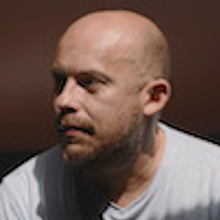La caricatura es una forma de ver la vida con humor y reflexión
Hoy esta sección se viste de gala nuevamente. Vamos a “dialogar” con un grande, entre los grandes. El caricaturista colombiano-español Omar Figueroa Turcios, o simplemente “Turcios”, como firma sus obras.
Unos breves datos para los pocos humornautas que quizás no lo conozcan: él ha…
-obtenido alrededor de 100 premios y distinciones internacionales.
-realizado innumerables exposiciones por el mundo.
-publicado en diarios y revistas de unos cuantos países.
-sido jurado y conferencista en muchísimas oportunidades.
Dicho lo anterior, comienzo entusiasmado este “diálogo”.
PP: Amigo mío, deseo te presentes como te gustaría que te hubiera presentado. Recuerda que es para que los que no te conocen (si eso fuera posible). Ah, y sin mucha modestia, porque sé que lo eres.
TURCIOS: Soy caricaturista, observador de la vida y el dibujo es mi instrumento de expresión.
Nací en Corozal (Sucre), Colombia. 1968. Me encanta la poesía, de hecho, los dibujantes somos poetas gráficos, realistas, surrealistas, con una visión al pasado muy a futuro.
PP: ¿Te gusta que le hagan entrevistas?
TURCIOS: Sí, porque me parece importante que quienes sigan la obra de uno se entere de primera mano de los recursos que usamos para dibujar y del proceso creativo. Por lo menos a mí me gusta leer entrevistas de los artistas que admiro y que cuenten sobre su obra, más que de su vida personal.
PP: ¿Es verdad la acuñada frase: "Es más fácil hacer llorar que hacer reír?
TURCIOS: Creo que sí, es que para hacer llorar no hace falta ser un genio, agarras un palo y pegas. Para hacer reír, primero hay que pensar.
PP: ¿El humorista nace o se hace?
TURCIOS: Nace, ya depende de él hasta qué grado quiere desarrollarlo. Es como la persona que no tiene oído, por más instrumentos que tenga o intente tocar, jamás le podrá salir una melodía.
PP: ¿Cuándo decidiste hacerse humorista?
TURCIOS: Yo quería primero hacer caricaturas de personajes, en los tiempos cuando acabé el bachillerato y donde toca hacer algo en la vida y me encontré con libros de los maestros Viuti, Fontanarrosa y Quino. Me di cuenta que podía hacer humor gráfico.
PP: Pero especifiquemos más. Sabemos que eres un especialista en caricatura personal. Por ahí empezaremos a profundizar entonces. Por ejemplo, ¿cuándo comenzaste a crear en esta modalidad y por qué la elegiste? ¿O ella te eligió a ti (para hacerme el profundo)?
TURCIOS: Fue la imagen de una caricatura fisonómica realizada por el maestro Jairo Linares de Colombia, la que me cautivó para ser caricaturista. Me pareció mágico ver a una persona exagerada, de forma humorística y que se identificara al personaje. Esa conjunción es mágica y pocas disciplinas en el arte la tienen. En la caricatura no hay matemática, es pura intuición, y eso es lo que me atrae, que cada dibujo es empezar de nuevo a buscar nuevos planteamientos.
Así que empecé a copiar caricatura de otros autores hasta que pude dibujar a gente de mi alrededor y podía sacarle el parecido, después seguí explorando hasta ir logrando poco a poco exagerarlas sin que se me perdiera el personaje. Entrar en esa búsqueda es lo que da el placer a dibujar, pero también el tormento si no te sale enseguida. Hay unas caras que salen al instante y otras, duras días boceteándola hasta que doy con ella.
PP: Te entiendo. Hay quien le llama a eso musa. Cuando está de "vacaciones" cuesta mucho lograr lo que uno desea. Pero como hemos aprendido, solo la perseverancia, el trabajo constante vence esos difíciles momentos. Pero sigamos. ¿Crees que hubo una evolución en tu obra, tu estilo, desde que comenzaste hasta la actualidad? No me refiero a la calidad de tu trazo debido a la mucha práctica, claro.
TURCIOS: Por supuesto, hay una evolución constante, desde mis inicios hasta hoy, cuando digo evolución, no significa ser mejor o peor sobre algún momento en este proceso de creación, sino que uno va cambiando algunas percepciones y en cada presente uno siente que está haciendo lo mejor posible, pero el tiempo dirá en el momento de mirar para atrás si hubo una época mejor o peor en cuando al estilo, y eso ya va en gusto tanto del autor cómo quién lo mira desde afuera.
PP: Claro, uno crece intelectualmente, madura, abraza otros conceptos. Turcios, cuéntanos cómo te enfrentas a un trabajo de caricatura personal. Me imagino que estudias los personajes si no los conoces personalmente. ¿Cómo es el proceso? ¿Qué te interesa saber más del personaje (no me refiero a lo físico, obvio).
TURCIOS: Sí, cuando voy a dibujar a una persona, busco la mejor referencia gráfica posible, sobre todo si el personaje es público. Hoy en día con los cientos de videos y miles de fotos, tenemos una idea más certera de las características del personaje. Recuerdo que los años 80s y 90s, tocaba ir a comprar revista o diarios que a veces salían fotos o tocaba ir a bibliotecas y sacar fotocopias del personaje para dibujarlo.
Comienzo por hacer el primer boceto de forma espontánea, sin ahondar mucho en la forma, sí en el parecido. Partiendo de este boceto, hago una caricatura de este boceto. Luego en el tercer intento, voy por la síntesis del boceto anterior y así hasta lograr el conjunto de máxima síntesis, sin perder el parecido del personaje dibujado.
PP: No sabes cómo te envidio. Me hubiera encantado tener el don de dibujar. Y más el talento tuyo para hacerlo. A propósito, ¿cómo es tener controlado el ego al recibir tanto reconocimiento? ¿Pensaste alguna vez que llegarías tan lejos antes de lanzarte en esta carrera?
TURCIOS: Soy muy consciente que ser caricaturista y explorar en nuevas formas lo lleva a uno a fallar más que acertar en los parecidos en los primeros y segundos intentos de sacar un parecido, esto a nivel personal uno está encerrado y rayando muchísimo. Eso la gente no lo sabe, hasta que ya publica uno la caricatura y parece sencillo el haberla hecho. Tengo muy claro que el reconocimiento lo tiene algunas obras concretas en sí, más yo no soy estrella de rock o del cine que anda pendiente de su apariencia de cara al público. Ni mi cara es reconocida en el supermercado. Esta profesión es perfecta para camuflarse.
Cuando uno empieza a dibujar, omo en cualquier arte, uno quiere que la obra sea reconocida, más no mi persona como personaje público.
PP: Es cierto, en el masivo público, cuando más, se hace famosa tu firma, no tu cara. Pero para los colegas, los periodistas de arte, los críticos, los interesados en el humor gráfico, los estudioso del tema, etc., que somos muchos en el mundo, eres famoso y reconocemos tu cara de tanto salir en las noticias al ganar tus premios. A eso me refería. Pero bueno, cambio de objetivo. Pasemos a teorizar un poco. Por ejemplo, ¿Cuál es para ti la definición de caricatura? Y específicamente, ¿cuál es tu definición de caricatura personal?
TURCIOS: La caricatura es una forma de ver la vida con humor y reflexión. Y en cuanto a caricaturizar a una persona, es buscar el alma del personaje a través de nuevos planteamientos físicos. Recuerdo que hace años en Bogotá, dibujé a un amigo y me dijo cuando le entregué la caricatura:" Nunca había visto algo tan distinto que se pareciera tanto a mí".
PP: Coincido contigo en en las definiciones. Aunque desde un punto de vista más teórico, aquí en Humor Sapiens también la definimos así: "La caricatura es un caso particular o recurso específico de la parodia, que consiste en simplificar los rasgos del modelo, abstrayendo y exagerando los más representativos o sobresalientes". Lo mismo que dijiste con otras palabras y poéticamente como haces siempre. Ahora, ¿crees que la caricatura personal pertenece al campo del humor gráfico? Te lo pregunto porque hay colegas que plantean que no toda la caricatura personal se hace para lograr una sonrisa.
TURCIOS: Ante todo para mí, la caricatura personal es arte, y siempre nos desprende una sonrisa, pequeña o grande, por lo tanto ya está generando humor. Así que claro, pertenece al género del humor.
PP: Sin duda alguna. Como te señalé antes, la caricatura es un caso extremo de la parodia, por lo que lleva implícito una burla y puede abarcar desde el puro juego formal, donde hasta la víctima ríe, hasta la sátira. Pero todo dentro del humor. Me alegro que coincidamos. Y paso a una pregunta de moda: ¿piensas que hay límites en el humor?
TURCIOS: El límite en el humor creo que es más una cuestión ética de cada autor al referirse o no a ciertos temas. Cada quién es libre de expresarse de la forma que quiera sobre el tema que desee. Otra cosa es que ofrezcas una caricatura de humor u opinión a un medio de comunicación, y según lo que ellos necesiten, te la publiquen o no. No es que sea censura si no la publiquen, es simplemente que no se ajusta a los criterios de ese medio de comunicación.
PP: Sí, es cierto. El mayor peso lo lleva la autocensura, porque depende del creador. Claro, existen los límites externos. Por ejemplo, en una dictadura, poe ejemplo, aunque quieras caricaturizar a un intocable no te dejarían. Bueno, de nuevo paso a tu obra y a tu persona. Has incursionado en el humor gráfico más allá de la caricatura personal. También te veo disfrutando mucho de tu serie de animales, que me encantan. ¿Te vas a otras modalidades porque te aburres un poco de hacer lo mismo siempre; es decir, de crear siempre caricatura personal? (Una humilde opinión: espero que nunca abandones la caricatura personal y espero que incursiones en todos los campos del humor gráfico. Se puede hacer todo al mismo tiempo, ¿no es cierto?).
TURCIOS: Me gusta probar siempre nuevas formas y temas, por eso lo he intentado con el humor gráfico a nivel concursos, mis animalitos que es mi recreo personal. Desde el 2011 hago a diario Opinión política de Colombia en EL HERALDO de Barranquilla, hago también pintura con acrílico sobre lienzo; pero la caricatura fisonómica siempre está presente y nunca la dejaré de hacer, a pesar que no le dedico el tiempo suficiente.
PP: Me alegro, amigo mío. Te doy mi palabra que soy fanático total a tus caricaturas personales. Otra cosa que me vino a la mente, ¿cómo es la convivencia profesional con tu esposa la gran caricaturista Nani?
TURCIOS: La convivencia con Nani es genial! porque tenemos temas en común de qué conversar y siempre hay tema a tratar y no aburrirse.
PP: Dale mis saludos a Nani y me alegro que tengan esa magnífica convivencia. Es tanta la compenetración de ustedes que hasta decidieron irse juntos a vivir a España. Y ahí te pregunto: ¿tu vida profesional en España cumplió las expectativas que te hiciste? Compara esa vida profesional en España con la vida en Colombia, tu país natal. Tengo un hijo dibujante, ilustrador, humorista gráfico también, que se fue de Chile a España “buscando nuevos horizontes”, como dice esa frase manida. ¿Ese es un consejo que le darías a los jóvenes que deciden seguir esta carrera?
TURCIOS: Uyy, ahí no me meto a sugerir nada en la vida de otra persona. Cada caso es personal y cada quién sabe si se siente bien saliendo o no de su país.
PP: Me refería a cuestiones de índole profesional como encontrar pocos espacios para publicar, que paguen menos, etc. Pero bueno, ¿qué pregunta te hubiera gustado que te hubiese hecho? ¿Podrías responderla ahora?
TURCIOS: La pregunta sería: ¿qué colores te gusta más usar? Y mi respuesta sería: los tonos azules y morados, que prevalezcan los tonos fríos, y que un ligero tono cálido entre al dibujo y haga el contraste necesario para hacer más atractiva la ilustración.
PP: Muy bien. Y para ir cerrando este "diáloco", ¿qué| me aconsejas a mí como humorista?
TURCIOS: No te dejes comer tanto de la realidad y mantener esa línea con lo surrealista para hacer más agradable la vida. Mantener esa chispa de humor que hace más llevadero todo.
PP: Perfecto. Buen aporte para disfrutar mejor tu obra. Y, ¿qué le dirías a nuestros seguidores de humorsapiens.com antes de despedirnos?
TURCIOS: Agradecer siempre estos espacios como el tuyo, dedicados al arte del humor gráfico y la caricatura, y hacer lupa de nuestros eventos y libros a través de esta gran web y portales en redes sociales.
PP: Bueno, amigo mío, espero que no hayas sufrido mucho en este “diálogo”. Por mi parte la pasé de maravillas. Y te agradezco enormemente que me hayas dedicado tu apreciado tiempo y tu esfuerzo para que esto saliera lo mejor posible. Te deseo mucha salud y por supuesto, te deseo que no se detengan jamás tus éxitos. Un abrazo, Maestro.
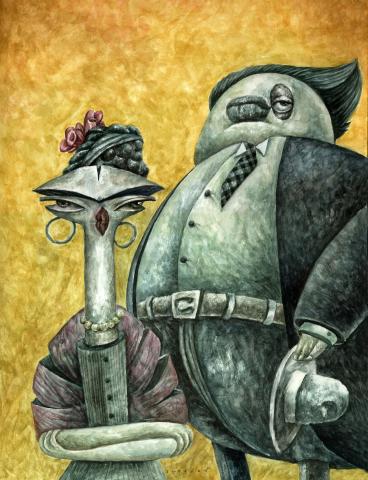
"Frida y Diego". Autor. Turcios
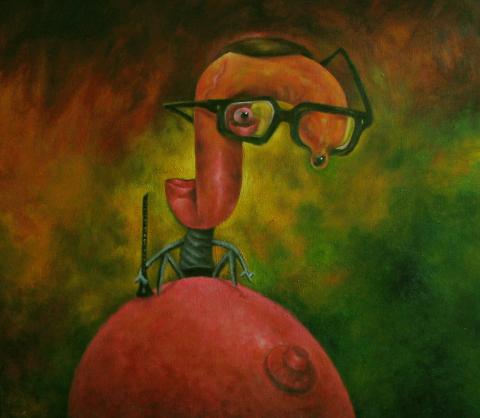
"Woody Allen". Autor: Turcios.
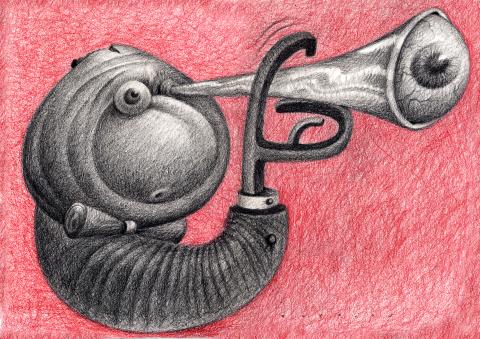
"Louis Armstrong". Autor: Turcios.
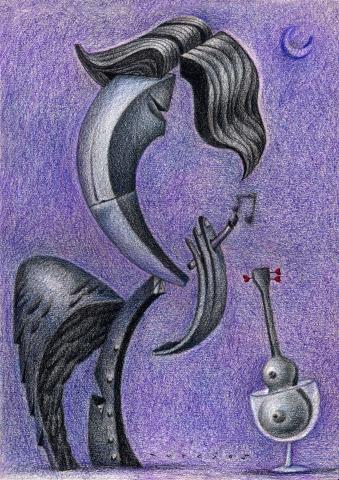
"Joaquín Sabina". Autor: Turcios.
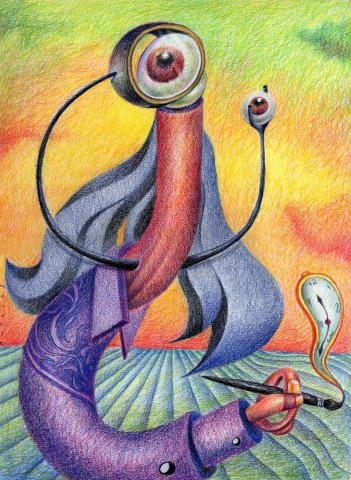
"Dalí". Autor: Turcios.
Interview with Turcios.
By Pepe Pelayo.
"Caricature is a way of seeing life with humor and reflection"
Today this section dresses up again. We are going to “dialogue” with a great, among the greats. The Colombian-Spanish cartoonist Omar Figueroa Turcios, or simply “Turcios”, as he signs his works.
Some brief information for the few humornauts who may not know him: he has…
-obtained around 100 international awards and distinctions.
-held countless exhibitions around the world.
-published in newspapers and magazines in a few countries.
-Been a jury member and speaker on many occasions.
Having said the above, I begin this “dialogue” enthusiastically.
PP: My friend, I wish you to introduce yourself as you would like me to have introduced you. Remember that it is for those who don't know you (if that were possible). Oh, and without much modesty, because I know you are.
TURCIOS: I am a caricaturist, an observer of life and drawing is my instrument of expression.
I was born in Corozal (Sucre), Colombia. 1968. I love poetry, in fact, cartoonists are graphic poets, realists, surrealists, with a vision of the past very far into the future.
PP: You are a specialist in personal caricature. We'll start there. For example, when did you start creating in this modality and why did you choose it? Or did she choose you (to play deep)?
TURCIOS: It was the image of a physiognomic caricature made by teacher Jairo Linares from Colombia, which captivated me to be a caricaturist. It seemed magical to me to see a person exaggerate, in a humorous way and for the character to be identified. That conjunction is magical and few disciplines in art have it. In cartoons there is no mathematics, it is pure intuition, and that is what attracts me, that each drawing is starting again to look for new approaches.
So I started to copy caricatures from other authors until I could draw people around me and I could draw their resemblance, then I continued exploring until I was able to little by little exaggerate them without losing the character. Entering into that search is what gives the pleasure of drawing, but also the torment if it doesn't come out right away. There are some faces that come out instantly and others, hard days sketching it until I find it.
PP: I understand you. There are those who call that muse. When you are on "vacation" it is very difficult to achieve what you want. But as we have learned, only perseverance, constant work overcomes those difficult moments. But let's continue. Do you think there was an evolution in your work, your style, from when you started to today? I'm not referring to the quality of your line due to a lot of practice, of course.
TURCIOS: Of course, there is a constant evolution, from my beginnings until today, when I say evolution, it does not mean being better or worse at any moment in this creation process, but rather that one changes some perceptions and in each present one feels that one is doing the best possible, but time will tell when we look back if there was a better or worse time in terms of style, and that already depends on the taste of both the author and those who look at it from the outside.
PP: Of course, one grows intellectually, matures, embraces other concepts. Turcios, tell us how you approach personal caricature work. I imagine you study the characters if you don't know them personally. How is the proccess? What are you interested in knowing more about the character (I'm not referring to the physical aspect, obviously).
TURCIOS: Yes, when I am going to draw a person, I look for the best graphic reference possible, especially if the character is public. Nowadays, with hundreds of videos and thousands of photos, we have a more accurate idea of the character's characteristics. I remember that in the 80s and 90s, I had to go buy magazines or newspapers that sometimes had photos or I had to go to libraries and make photocopies of the character to draw them.
I start by making the first sketch spontaneously, without delving too deeply into the shape, but rather into the resemblance. Starting from this sketch, I make a caricature of this sketch. Then in the third attempt, I go through the synthesis of the previous sketch and so on until I achieve the maximum synthesis set, without losing the similarity of the drawn character.
PP: You don't know how I envy you. I would have loved to have the gift of drawing. And more your talent to do it. By the way, what is it like to have your ego under control when receiving so much recognition? Did you ever think you would get this far before launching into this career?
TURCIOS: I am very aware that being a caricaturist and exploring in new ways leads one to fail more than to get the similarities right in the first and second attempts to draw a similarity, this on a personal level one is locked in and very scratchy. People don't know that until one publishes the cartoon and it seems easy to have made it. I am very clear that recognition is given to some specific works themselves, but I am not a rock or movie star who is aware of their appearance in front of the public. Not even my face is recognized in the supermarket. This profession is perfect for camouflage.
When one begins to draw, as in any art, one wants the work to be recognized, but not my person as a public figure.
PP: It's true, in the mass public, at most, your signature becomes famous, not your face. But for colleagues, art journalists, critics, those interested in graphic humor, students of the subject, etc., of which there are many in the world, you are famous and we recognize your face from being in the news so much when you win your awards. That is what I meant. But hey, change of objective. Let's theorize a little. For example, what is the definition of a caricature for you? And specifically, what is your definition of a personal caricature?
TURCIOS: Caricature is a way of seeing life with humor and reflection. And as for caricaturing a person, it means searching for the soul of the character through new physical approaches. I remember that years ago in Bogotá, I drew a friend and he told me when I gave him the caricature: "I had never seen something so different that looked so much like me."
PP: I agree with you on the definitions. Although from a more theoretical point of view, here at Humor Sapiens we also define it like this: "Caricature is a particular case or specific resource of parody, which consists of simplifying the features of the model, abstracting and exaggerating the most representative or outstanding ones." . The same thing you said in other words. Now, do you think that personal caricature belongs to the field of graphic humor? I ask you this because there are colleagues who suggest that not all personal caricature is done to achieve a smile.
TURCIOS: Above all, for me, personal caricature is art, and it always gives us a smile, small or big, therefore it is already generating humor. So of course, it belongs to the genre of humor.
PP: Without a doubt. As I pointed out before, caricature is an extreme case of parody, so it implies mockery and can range from pure formal play, where even the victim laughs, to satire. But all within humor. I'm glad we agree. And I move on to a fashionable question: do you think there are limits to humor?
TURCIOS: I think the limit in humor is more of an ethical question for each author when referring or not to certain topics. Everyone is free to express themselves in the way they want on the topic they want. Another thing is that you offer a cartoon of humor or opinion to a media outlet, and depending on what they need, they will publish it or not. It's not that it's censorship if they don't publish it, it's simply that it doesn't fit the criteria of that media outlet.
PP: Yes, it's true. The greatest weight is carried by self-censorship, because it depends on the creator. Of course, there are external limits. For example, in a dictatorship, even if you want to caricature an untouchable, they wouldn't let you. Well, once again I turn to your work and your person. You have ventured into graphic humor beyond personal caricature. I also see you really enjoying your animal series, which I love. Are you going to others modalities because you get a little bored of always doing the same thing; That is, to always create a personal caricature? (A humble opinion: I hope you never abandon personal caricature and I hope you venture into all fields of graphic humor. You can do everything at the same time, right?
TURCIOS: I always like to try new forms and themes, that's why I have tried graphic humor at the contest level, my little animals, which is my personal recreation. Since 2011 I have been writing Political Opinion of Colombia on a daily basis in EL HERALDO in Barranquilla, I also paint with acrylic on canvas; but the physiognomic caricature is always present and I will never stop doing it, even though I don't dedicate enough time to it.
PP: I'm glad, my friend. I give you my word that I am a total fan of your personal caricatures. Another thing that came to mind, what is your professional life like with your wife, the great cartoonist Nani?
TURCIOS: Living with Nani is great! because we have common topics to talk about and there is always a topic to discuss and not get bored.
PP: Give my regards to Nani and I am glad that you have such a magnificent coexistence. Your understanding is so great that you even decided to go live together in Spain. And there I ask you: did your professional life in Spain meet the expectations you made for yourself? Compare that professional life in Spain with life in Colombia, your native country. I have a son who is a cartoonist, illustrator, and cartoonist too, who left Chile for Spain “looking for new horizons,” as that hackneyed phrase goes. Is that advice you would give to young people who decide to follow this career?
TURCIOS: Wow, I'm not trying to suggest anything in someone else's life. Each case is personal and everyone knows if they feel good leaving their country or not.
PP: I was referring to professional issues such as finding few spaces to publish, that pay less, etc. But well, to close the “dialogue”, what question would you like me to have asked you? Could you answer it now?
TURCIOS: The question would be: what colors do you like to use the most? And my answer would be: blue and purple tones, let cold tones prevail, and let a slight warm tone enter the drawing and create the necessary contrast to make the illustration more attractive.
PP: Perfect. Good contribution to better enjoy your work. And what would you say to our humorsapiens.com followers before we say goodbye?
TURCIOS: Always be grateful for these spaces like yours, dedicated to the art of graphic humor and caricature, and magnify our events and books through this great website and portals on social networks.
PP: Well, my friend, I hope you have not suffered much in this “dialogue.” For my part, I had a wonderful time. And I greatly appreciate that you have dedicated your appreciated time and effort to making this go as smoothly as possible. I wish you good health and of course, I hope that your successes never stop. A hug, Master.
(This text has been translated into English by Google Translate)

